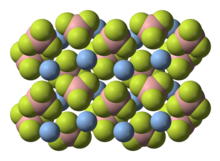 | |
| Names | |
|---|---|
| IUPAC name Silver tetrafluoridoborate(1–) | |
| Other names Borate(1-), tetrafluoro-, silver(1+) Argentous tetrafluoroborate | |
| Identifiers | |
3D model (JSmol) | |
| ChemSpider | |
| ECHA InfoCard | 100.034.491 |
| EC Number |
|
PubChem CID | |
| RTECS number |
|
CompTox Dashboard (EPA) | |
| |
| |
| Properties | |
| AgBF4 | |
| Molar mass | 194.673 g/mol |
| Appearance | Off-white powder |
| Odor | almost odorless |
| Density | 4.16 g/cm3 |
| Melting point | 71.5 °C (160.7 °F; 344.6 K) (monohydrate) |
| soluble | |
| Hazards | |
| GHS labelling: [1] | |
 | |
| Danger | |
| H314 | |
| P260, P264, P280, P301+P330+P331, P303+P361+P353, P304+P340, P305+P351+P338, P310, P321, P363, P405, P501 | |
| NFPA 704 (fire diamond) | |
| Safety data sheet (SDS) | External MSDS |
Except where otherwise noted, data are given for materials in their standard state (at 25 °C [77 °F], 100 kPa). | |
Silver tetrafluoroborate is an inorganic compound with the chemical formula AgBF4. It is a white solid, although commercial samples often are gray, that dissolves in polar organic solvents as well as water. [2]

